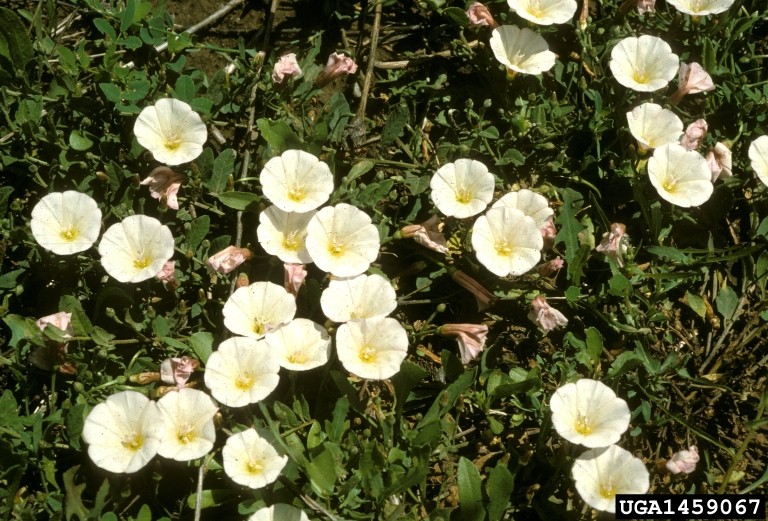Convolvulus arvensis
Field Bindweed / Creeping Jenny
Synonyms: Convolvulus ambigens, C. incanus, Strophocaulos arvenis
Class: Magnoliopsida
Order: Solanales
Family: Convolvulaceae

Photographer: Steve Dewey, Utah State University
Source: invasive.org
Description
Field bindweed (Convolvulus arvensis) is a deep-rooted, vine-like and perennial plant from the Morning-glory family. The stems of this plant sprawl along the ground or wrap around objects and they can reach up to 6.5 feet in length. The leaves are alternate and arrowhead in shape but they can sometimes look almost oval. Flowers are small (.5-1 inch) and trumpet shaped, with 5 fused petals and can be pink to white in color. Flowering can continue as long as the stems are growing, which occurs until the plants frost over. The root system includes a perennial taproot that can go 10 feet deep. Several creeping roots stem off of the taproot and rhizomes associated with the creeping roots are also present can create independent plants. One plant may have a root system 20 feet in diameter and 30 feet deep. Fruits on the plant are smooth cone-shaped capsules with four parts and four dark-brown ovoid seeds. New shoots from rhizomes emerge in early spring and pieces as small as 2 inches can produce new growth. Luckily, the rhizomes will die if the ground freezes.
Ecological Threat: Since field bindweed is able to rapidly spread this plant is difficult to control, and considered one of the worst weeds in agricultural fields. It can reduce crop yields of cereal grains by 40% and can outcompete vegetable seedlings. Since this plant can out-compete nateive plants it quickly reduces biodiversity in habitats. By having an extensive root system this plant can steal nutrients and water from the crops and actually increase irrigation costs. Also, field bindweed can be an alternate host for viruses that affect crops, such as Potato X Disease, Tomato Spotted Wilt and Vaccinum False Bottom, making this plant an unwelcomed one.
Biology: Convolvulus arvensis reproduces by seed and vegetatively. However, seed production can be variable and more seeds are produced under dry sunny conditions from plants in calcareous soil. Rain and heavy wet soils actually reduces seed production. In the second season is when the plants usually flower and set seeds and one plant can produce up to 500 seeds. Most seeds fall near the parent plant but some are carried away by birds, water, other animals and agricultural activity. Unfortunately, the seeds remain viable from 20-50 years making it hard to prevent re-sprouting and therefore eradication.
History: This plant was introduced to the United States in the 1730s for use in medicine and as an ornamental. However, it was considered a weed in European gardens a 100 years before United States introduction. By 1875, it was considered a weed in North America.
U.S. Habitat: Is most abundant in disturbed sites like pastures, roadsides, cultivated fields, orchards, vineyards and even gardens.
Distribution
Native Origin: Eurasia and northern Africa
U.S. Present: All states except Alaska
Resembles/Alternatives
Field Bindweed resembles the native western morning glory (Calystegia occidentalis), which can also be a weedy pest in agricultural fields. However, it is differentiation by its preference for chaparral habitats and the leaves are squared or indented with two lobes. Field bindweed can also be confused with Ipomoea species but the sepals in the flowers of Ipomoea are not fused.
Management
Control and prevention depends on if the site is natural or agricultural. Consistent maintenance of vegetative cover can prevent the establishment of field bindweed. Once this plant is established it is extremely difficult to eradicate. Physical control has to be carefully timed so it doesn’t stimulate rhizome growth. Luckily, small plants and new infestations can be pulled by hand. Cattle and sheep avoid consuming bindweeds but hogs and chickens will eat any exposed areas of the plants. In orchards or vineyards a cover of ryegrass and red clover will shade the field bindweed and reduce its population. Herbicide applications repeated over several years can suppress field bindweed enough to make it manageable; however, some biotypes can be resistant to chemical treatments. For the herbicides to be effective they must be applied before seed sets; but they can be less effective when the plants are drought-stressed.
References
Coombs, E. M., et al., Eds. 2004. Biological Control of Invasive Plants in the United States. Corvallis: Oregon State University Press, 151.
Woodward, Susan L., and Joyce Ann. Quinn. 2011. Field Bindweed. Encyclopedia of Invasive Species: From Africanized Honey Bees to Zebra Mussels. Santa Barbara, CA: Greenwood. 606-09. Print.
Zollinger, R. K., & Lym, R. G. 2010. Identification and control of field bindweed.
Internet Sources
http://plants.usda.gov/core/profile?symbol=COAR4
http://oregonstate.edu/dept/nursery-weeds/email_pubs/bindweed/field_bindweed_email.html
http://www.calflora.net/bloomingplants/westernmorningglory.html
http://www.gardenorganic.org.uk/organicweeds/weed_information/weed.php?id=71
 Texas Invasive Species Institute
Texas Invasive Species Institute